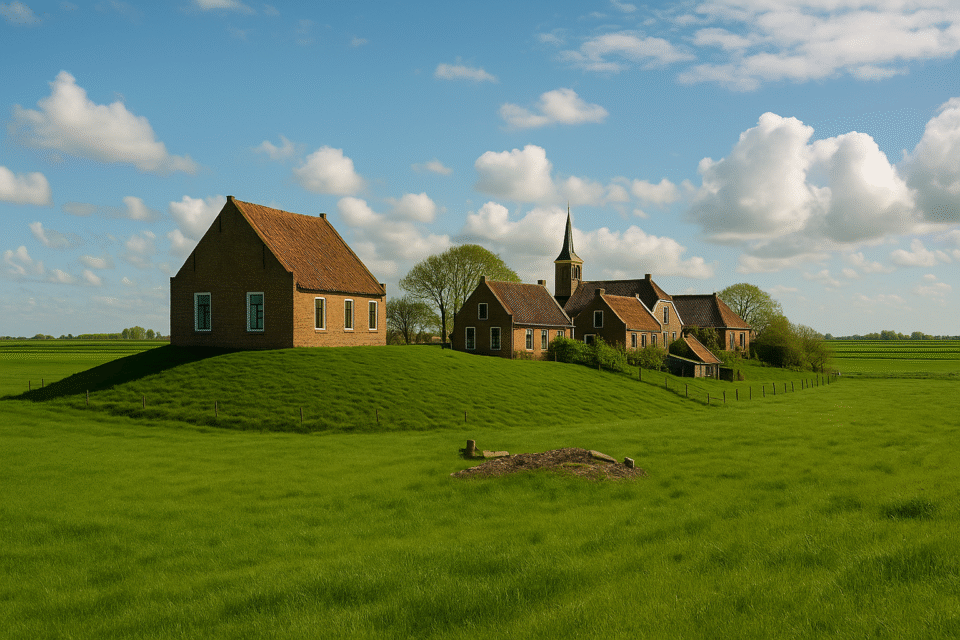The Netherlands’ most celebrated historical period continues to shape Dutch identity today. For Americans exploring Dutch culture, understanding this transformative era provides valuable insights into everything from art museums to business practices—and reveals surprising Dutch contributions to American institutions.
Walking through Amsterdam’s canal belt today, you’re literally strolling through history. Those elegant canal houses with their distinctive gabled facades? They’re physical remnants of one of history’s most remarkable economic and cultural booms. The Dutch Golden Age transformed a small, newly independent collection of provinces into a global powerhouse whose influence extended from Wall Street to the art world. For Americans visiting or considering life in the Netherlands, understanding this formative period offers more than historical trivia—it provides essential context for modern Dutch society and reveals how Dutch innovations quietly shaped American institutions we often take for granted.
What Was the Dutch Golden Age?
The Dutch Golden Age refers to a period in Dutch history spanning roughly from 1588 to 1672 when the Dutch Republic (the predecessor to today’s Netherlands) experienced unprecedented prosperity and cultural achievement. This remarkable period began after the Dutch successfully revolted against Spanish rule, establishing their independence and creating a republic in a Europe dominated by monarchies.
What makes this period so extraordinary is the sheer scale of Dutch success despite the country’s small size. At its peak during the 17th century, the Dutch Republic became the world’s leading economic and maritime power, with the highest per capita income of any country. Amsterdam transformed from a regional port into a global financial center, while Dutch merchants established trading networks across Asia, Africa, and the Americas.
This wasn’t just an economic phenomenon. The Golden Age saw extraordinary achievements in art, science, and philosophy. Names like Rembrandt, Vermeer, and Spinoza emerged during this era, creating works that continue to influence global culture today.
How Did a Tiny Nation Become So Powerful?
For American visitors, the scale of Dutch success during this period can be difficult to comprehend. Imagine if Rhode Island became the world’s dominant economic power while simultaneously producing some of history’s greatest artistic masterpieces. How did they do it?
Commercial Innovation
The Dutch pioneered financial and commercial innovations that Americans might find surprisingly modern. The Dutch East India Company (VOC), founded in 1602, was the world’s first multinational corporation and the first company to issue stocks and bonds to the public. In fact, many financial instruments that power today’s global economy—from joint-stock companies to stock exchanges—were either invented or perfected in Golden Age Netherlands.
Amsterdam’s stock exchange, established in 1602, predates the New York Stock Exchange by nearly 200 years. For Americans working in finance, it’s worth noting that Wall Street’s very name comes from a wall built by Dutch settlers in New Amsterdam (later New York) during this period.
Religious Tolerance and Intellectual Freedom
While much of Europe was torn apart by religious wars, the Dutch Republic developed a pragmatic approach to religious differences. The Republic became known for its relative religious tolerance, providing refuge for persecuted groups from across Europe, including French Huguenots, Portuguese and Spanish Jews, and English Puritans.
This tolerance wasn’t motivated solely by idealism—Dutch leaders recognized that welcoming skilled immigrants regardless of faith could strengthen the economy. This pragmatic approach allowed Amsterdam to attract talented merchants, artisans, and thinkers from across Europe, fueling further innovation.
For Americans, this offers an interesting historical parallel. Just as the United States later benefited from becoming a destination for ambitious immigrants, the Dutch Republic’s openness to outsiders became one of its greatest competitive advantages.
Scientific and Cultural Achievement
The period’s prosperity supported a flourishing of knowledge and art. Dutch universities attracted scholars from across Europe, while scientific pioneers like Anton van Leeuwenhoek (who perfected the microscope) and Christiaan Huygens made groundbreaking discoveries.
Perhaps most famously, Dutch painting reached extraordinary heights during this period. The so-called “Dutch Masters” like Rembrandt van Rijn and Johannes Vermeer created works characterized by their technical brilliance, observation of daily life, and innovative use of light. Unlike the religious and mythological subjects favored elsewhere, Dutch artists often painted everyday scenes and ordinary people—a democratic approach to art that reflected the republic’s values.
Dutch Golden Age Influence on America
For American visitors to the Netherlands, it’s worth appreciating how profoundly this small nation influenced American development—in ways many Americans rarely consider.
Financial Systems and Wall Street
The American financial system owes significant debts to Dutch innovations. When the Dutch settled New Amsterdam (later New York), they brought their commercial practices with them. Wall Street, the symbolic heart of American capitalism, takes its name from “de Waal Straat,” a defensive wall built by Dutch colonists to protect their settlement.
More fundamentally, many financial instruments Americans use today have Dutch Golden Age origins:
- The first modern stock exchange was established in Amsterdam in 1602, providing a model that would eventually be adapted for American markets.
- Mutual funds have Dutch roots—investment trusts that pooled investor resources originated during this period with the slogan “unity creates strength.”
- The concept of buying shares in a company, which underpins modern capitalism, was popularized through the Dutch East India Company (VOC), which allowed ordinary citizens to invest in global trade.
American Political Foundations
The Dutch Republic’s governmental structure provided an important alternative model to monarchy during America’s formative period:
- The Dutch Republic’s federal structure—with provinces maintaining significant autonomy while cooperating on matters of common interest—influenced early American federalism.
- Religious tolerance practiced in the Dutch Republic became an important reference point for America’s founders, especially for figures like William Penn, whose mother was Dutch and who established Pennsylvania partly based on Dutch principles of religious freedom.
- The Founding Fathers were well aware of the Dutch Republic’s governmental experiment—John Adams wrote extensively about the Dutch political system, and aspects of its republican model informed American constitutional thinking.
Language and Culture
The Dutch language has left surprising marks on American English:
- Common American English words with Dutch origins include “cookie” (koekje), “boss” (baas), “stoop” (stoep), “coleslaw” (koolsla), and “Santa Claus” (Sinterklaas).
- New York’s geography still reflects its Dutch beginnings—neighborhoods like Brooklyn (Breukelen), Harlem (Haarlem), and the Bronx (named after settler Jonas Bronck) all preserve their Dutch heritage in modified form.
- Even American Christmas traditions have Dutch roots—the Santa Claus figure evolved partly from the Dutch Sinterklaas celebrations brought to America by early settlers.
Art and Education
- Dutch artistic traditions influenced early American art, particularly in the Hudson River School of painting, which blended European techniques with American landscapes.
- The emphasis on widespread literacy and education that characterized the Dutch Republic helped shape early American educational values, especially in New York and New Jersey. Notably, Rutgers University was founded in 1766 as Queen’s College by ministers from the Dutch Reformed Church.
Science and Medicine
- Dutch scientific advances during the Golden Age, particularly in optics and microscopy by figures like Anton van Leeuwenhoek, contributed to scientific method practices that shaped American scientific development.
- Dutch medical training was considered among Europe’s most advanced during this period, influencing early American medical practice through books and practitioners.
The Golden Age in Today’s Netherlands
For Americans exploring the Netherlands today, the Golden Age isn’t just history—it remains a living influence on contemporary Dutch culture, visible in everything from architecture to attitudes.
Visual Legacy
The most obvious Golden Age remnants are physical. Amsterdam’s canal ring (grachtengordel), a UNESCO World Heritage site, was largely constructed during the 17th century. For American visitors, these picturesque waterways aren’t just photo opportunities—they’re the infrastructure of history, built to facilitate the trade that made the Golden Age possible.
Museums across the Netherlands showcase the artistic achievements of this period. The Rijksmuseum in Amsterdam houses Rembrandt’s famous “Night Watch,” while the Mauritshuis in The Hague displays Vermeer’s “Girl with a Pearl Earring.” For Americans accustomed to seeing European art primarily in U.S. museums, experiencing these masterpieces in their cultural context adds a deeper dimension of understanding.
Cultural Values and Business Practices
More subtly, many characteristics that Americans notice in modern Dutch society have roots in Golden Age values:
- Commercial pragmatism: The Dutch approach to business often combines innovation with practicality—a mindset that helped Golden Age merchants outcompete larger nations.
- Global outlook: Despite being a small country, the Netherlands maintains a remarkably international perspective, with Dutch companies and professionals working worldwide—a continuation of Golden Age trading patterns.
- Consensus-building: The Dutch “polder model” of decision-making through consultation has historical roots in how different provinces and interests needed to cooperate during the republic era.
- Design sensibility: The Dutch reputation for clean, functional design (visible everywhere from architecture to product design) connects to a Golden Age tradition of combining aesthetics with practicality.
National Identity and Critical Reflection
For Americans considering deeper engagement with Dutch culture, it’s important to understand the complex role the Golden Age plays in national identity. Dutch people often feel pride in this heritage while simultaneously engaging in critical examination of its darker aspects.
The wealth of the Golden Age was partially built on colonial exploitation, including the Dutch participation in the transatlantic slave trade. Modern Dutch society increasingly acknowledges these aspects of its history, with museums and cultural institutions working to present more complete narratives about the period.
This willingness to critically examine national history—celebrating achievements while acknowledging failings—represents an important aspect of contemporary Dutch culture that Americans will encounter, particularly in educational contexts.
Where to Experience Dutch Golden Age Influence Today
For Americans visiting the Netherlands or the US, these locations offer tangible connections to the Dutch Golden Age and its transatlantic influence:
In the Netherlands:
- Amsterdam’s Canal Ring: Walk along the Herengracht, Keizersgracht, and Prinsengracht to see the physical infrastructure of Golden Age wealth.
- Rijksmuseum: Beyond famous paintings, look for the detailed model ships and trade goods that show how Dutch commercial power operated.
- Amsterdam Museum: Offers context for how the city developed during this critical period.
- Dutch West India House in Middelburg: See the headquarters from which Dutch colonial expeditions to America were planned.
In the United States:
- New Amsterdam Trail in Lower Manhattan: Follows the outline of the original Dutch settlement.
- Brooklyn’s Historic Districts: Areas like Flatlands and Flatbush preserve street patterns from their Dutch village origins.
- New York Historical Society: Features collections related to Dutch influence on early New York.
- Albany Institute of History & Art: Houses significant collections related to Dutch settlement in the Hudson Valley.
Conclusion
For Americans exploring the Netherlands, the Golden Age provides essential context for understanding not just Dutch society but aspects of American identity that have Dutch roots. This remarkable period wasn’t simply a distant historical curiosity—it represents a crucial channel through which European ideas about commerce, governance, and culture flowed into early American development.
When you visit historical sites in the Netherlands or notice Dutch place names throughout the northeastern United States, you’re witnessing connections forged during this transformative era. The pragmatic problem-solving, entrepreneurial spirit, and balance between individual opportunity and social cohesion that characterized the Dutch Golden Age left lasting imprints on both nations—creating a shared heritage that continues to reward exploration.
Whether you’re planning a brief visit to Amsterdam’s museums or considering a deeper engagement with Dutch culture, understanding the Golden Age offers valuable insight into how a small nation created global influence that continues to shape our world today.







